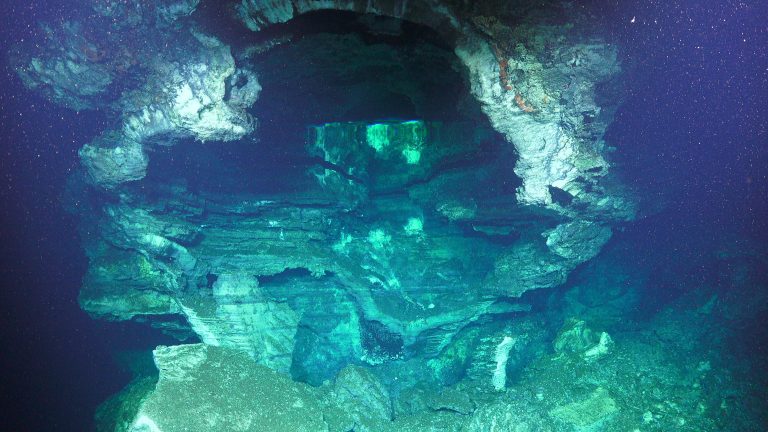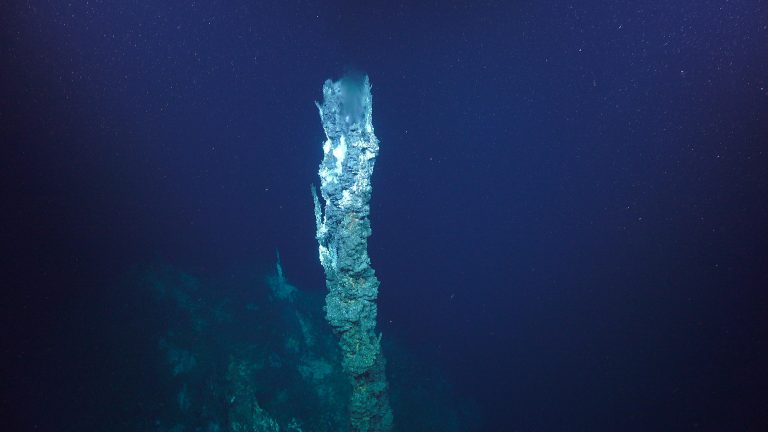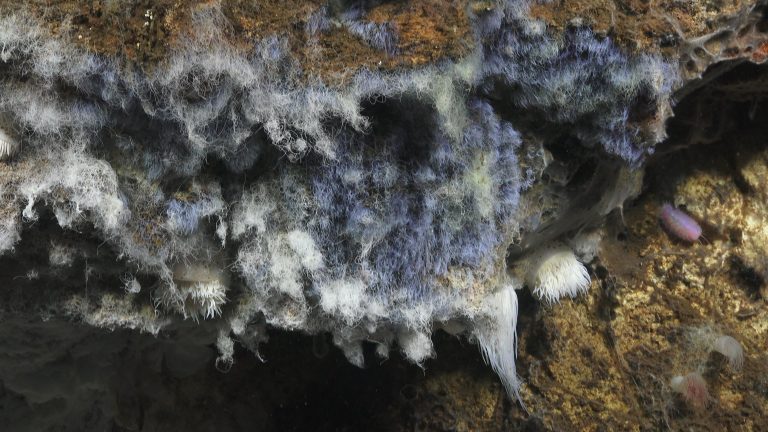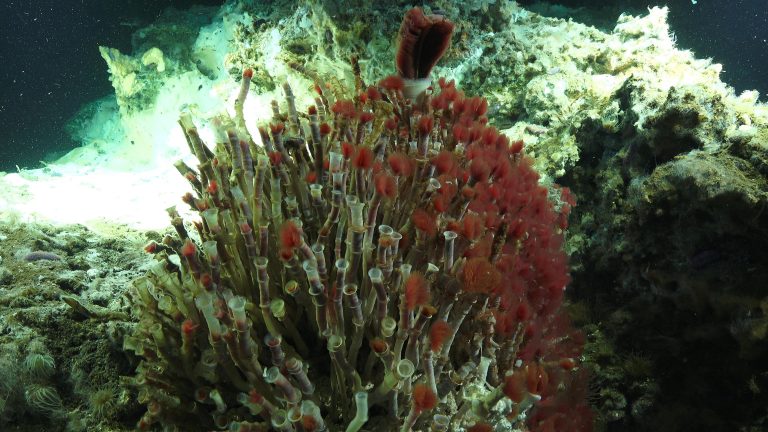“The landscape at the hydrothermal vent fields in the Pescadero Basin is stunning and unlike any we have seen.”
Drawn to the mysteries of the Auka hydrothermal vent field, our interdisciplinary team of scientists arrived eager to explore a diverse and vibrant ecosystem thriving in an extreme environment of unique geochemistry. We were not disappointed. Holes in the seafloor gushing high temperature fluids, steaming hot sediments laden with orange-colored oil and the rotten-egg stink of sulfide, mineral flanges stretching horizontally like tabletops channeling hydrothermal fluids into upside-down lakes and waterfalls – the Pescadero hydrothermal vent fields boast a dramatic and intimate beauty far beyond the familiar and charismatic hydrothermal chimney. Nearly everywhere that we train our ROV-aided eyes in this seemingly-alien landscape, we see life finding its way, astonishing us with biological innovations and challenging us to unravel the secrets to its survival.
Now reaching the end of our cruise, we are excited to share our discoveries with you and give you a hint of some exciting science yet to come.
Discovery: A New Vent Field
Let us introduce you to Jaich Maa, a new hydrothermal vent field discovered during this cruise in the southern Pescadero Basin. Only two kilometers away from the Auka field, Jaich Maa seems to have a similar geochemistry and biological community structure to the Auka vent field. The largest vent of the new field, Tay Ujaa, entranced us with its cavern constructed of the hydrothermally precipitated calcite; a cavern that held a pool of shimmering water before it escaped the rim in an upside-down waterfall. In fact, it was these features that inspired the vent field’s new names. Naming new features as we explore is a job taken very seriously by scientific teams, and our team is no exception. Following the tradition of the 2015 cruise to this region, the vents have been named using words from some of the local languages of the Baja Peninsula. Tay Ujaa (with its large cavern) means “big cave”, and Jaich Maa means “liquid metal,” inspired by the metallic shimmering of the upside-down lake. The exploration of the Jaich Maa vent field has only just begun, but our scientific team is unanimous in the belief that this area deserves a great deal more investigation.

A Revolutionary New Map
Mapping using shipboard, AUV, and ROV-mounted technologies has been a great success on this cruise. The discovery of the Jaich Maa vent field was made possible by the Monterey Bay Aquarium Research Institute’s (MBARI) AUV, which spent many hours traversing the Pescadero Basin at 50 meters above the seafloor, mapping at meter-scale resolution and searching for spikes in temperature that indicate hydrothermal venting. That mapping effort also led to the discovery of an active tectonic spreading center in the northern Pescadero Basin. The ROV-mounted, low altitude imaging (also an MBARI imaging system), successfully mapped a 100 by 400 meter section of the Auka vent field. The initial low altitude maps proved invaluable for strategic sampling and exploration during this cruise, and when all the data is processed, the centimeter-scale resolution maps will allow an unprecedented look at the geology and biology of the vent field.
The Heat is Flowing
Hydrothermal vents are known for their high temperature fluids, which get as toasty as 290 degrees Celsius in the warmest vents of the Auka and Jaich Maa vent fields. As impressive as those high temperatures are, there is a far larger story of heat, energy, and the dynamic nature of Pescadero Basin that we have now glimpsed for the first time. High resolution heat flow measurements were taken across the Auka vent field that will help us understand the plumbing of the system: how far down the magma source is, where heat and fluids are traveling more easily along fault lines, and how permeable the sediments are. These heat flow measurements are hinting at a fascinating geologic evolution and structure below the visible vents.

Biology: Something New, Something Blue
New species, new behaviors, blue microbes!? We were still discovering new species at the new Jaich Maa vent field on the final dive, and as you might imagine, we are quite confident there are still new things out there to be found. Much of the work and scientific discovery is still to come, as the gathered samples are taken back to land for analysis, but we can share a few field observations. These vent sites host diverse communities, but there are a handful of animals that seem to dominate: Oasisia tubeworms, anemones, and brilliant blue scale worms. We were fortunate to observe some surprising behaviors and interactions between organisms, including a rather thrilling contact of unknown significance between two scale worms. We successfully found a few organisms that were being specifically sought, such as the sock-like Xenoturbella. The DNA analysis of this and other organisms will teach us not only more about their nature and lifestyles, but also about the structure of the tree of life. We really did find blue microbes, and are looking forward to investigating the nature of the coloration; is it pigmentation, a new type of filamentous bacteria, or the inclusion of a mineral? We successfully collected sediment cores that span temperatures from 23 to over 200 degrees Celsius, which will allow us to investigate the microbial life in these strange, oily, and very hot environments, right up to the temperature limits of life. From the microbial communities we have glimpsed in the hydrocarbon-rich rock interiors, to the colorful shades of microbial mats coating the seafloor, we anticipate making some valuable progress toward our goal of understanding the interactions between the geochemistry and the life here among the hydrothermal vents.

So Much Left To Discover
We are fond of reminding ourselves and others that more than 90% of the ocean floor has yet to be explored. Our research here in the Pescadero Basin is a wonderful example of the oceanic treasures still waiting to be discovered.


